Last Updated on February 3, 2025 by Owen McGab Enaohwo
![How to Design an Effective Hiring Process to Attract Top Talent [Steps & Examples]](https://www.sweetprocess.com/wp-content/uploads/2025/01/hiring-process.png)
Every successful hiring story starts with an effective hiring process. Maybe you’ve been burned by the wrong fit before, a hire that didn’t pan out, or a promising candidate who slipped through the cracks.
You receive many applications, and you’re staring down at a stack of resumes, wondering where to begin. The question running through your mind is, “How do successful companies attract top talent, avoid costly missteps, and keep their hiring process efficient without losing that personal touch?”
In this guide, we’ll explore what you need to know about designing an effective hiring process that attracts top talent and aligns with your company’s goals. Plus, we’ll walk you through how tools like SweetProcess simplify the entire journey, from creating workflows to onboarding seamlessly.
What You’ll Learn In This Guide:
Why Is the Hiring Process Important?
How to Develop a Best-in-Class Hiring Process That Attracts Top Talent
How to Manage Your Company’s Hiring Process Using SweetProcess
Hiring Process vs. Onboarding Process: How They Differ
5 Hiring Process Examples to Inspire Your Team
9 Benefits of the Hiring Process in an Organization
Recruit Top Talent for Your Team With SweetProcess
Why Is the Hiring Process Important?
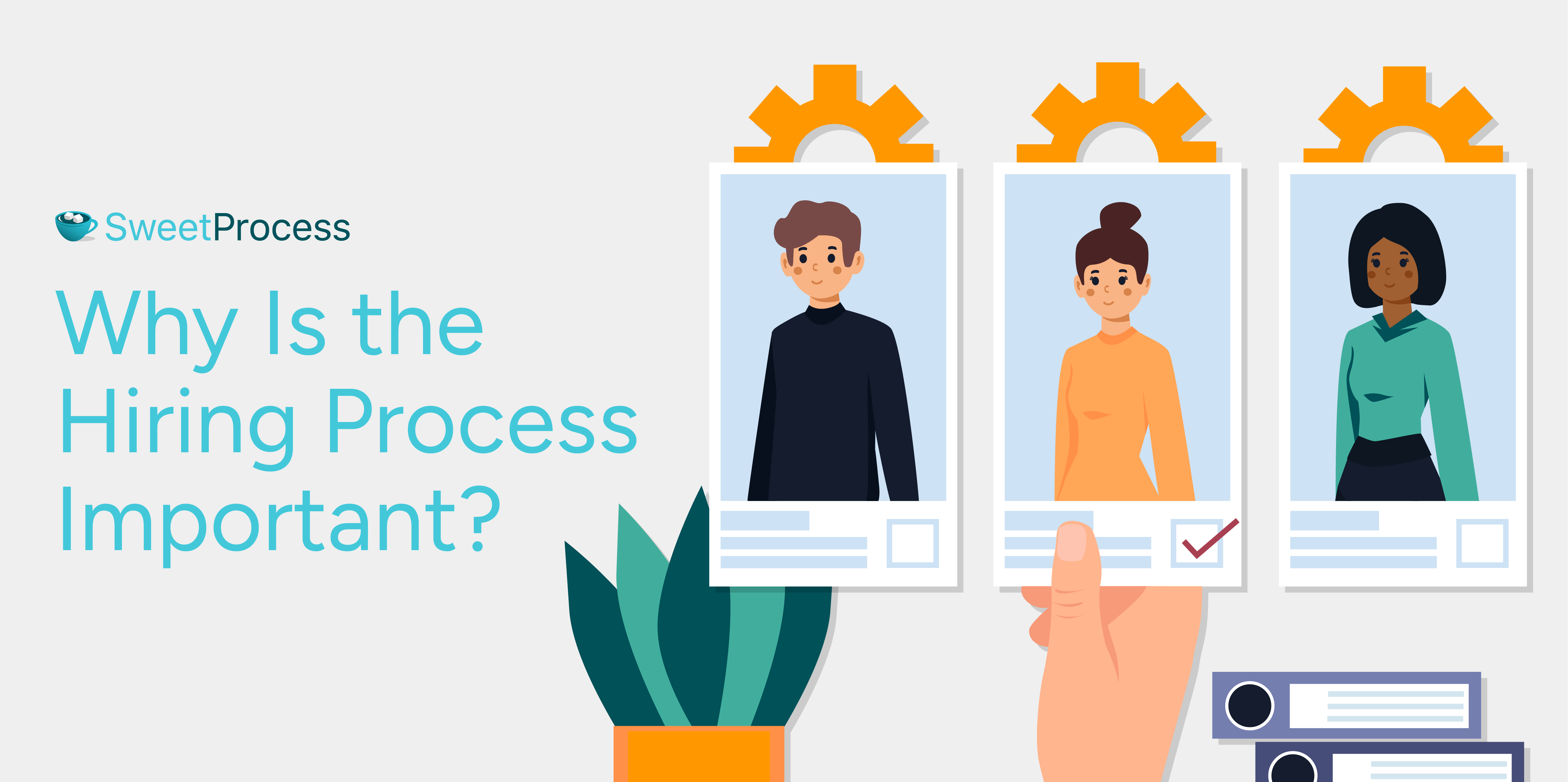
Putting together a team is like creating a masterpiece; each hire is crucial. Get it right, and everything falls into place. Get it wrong, and the whole picture suffers.
A thoughtful hiring process helps you find someone qualified and supports your goal of building thriving teams, inspiring cultures, and successful businesses.
Let’s examine why the hiring process is crucial and how it can transform your business.
Create a Positive Candidate Experience
First impressions are everything, right? The hiring process is a candidate’s first real glimpse into your company. If it’s messy, disorganized, or impersonal, they’ll notice and judge your company culture based on it. However, a smooth, respectful process shows that you value people, not just positions. And when candidates feel valued, they’re more likely to join your team enthusiastically.
Avoid Unconscious Bias
Hiring involves giving every applicant a fair shot, but unconscious biases can creep in without a structured process, affecting who gets considered and who doesn’t. Bias isn’t always obvious or intentional. It’s subtle, like leaning toward someone who “feels” like a good fit because they remind you of yourself. A transparent, objective hiring process helps remove these blind spots, opening doors to more diverse talent.
Hire the Right Candidates
Ever heard the saying, “Hire slow, fire fast”? It’s popular for a reason. The true cost of a bad hire goes beyond major financial loss. It drains morale, disrupts workflows, and creates headaches for everyone involved. An effective hiring process, on the other hand, ensures you’re not just filling a seat but finding someone genuinely aligned with the role and the team.
Allows Companies to Hire Individuals Who Value the Same Principles
Shared values are the glue that holds great teams together. Without a thoughtful hiring process, it’s easy to overlook whether a candidate’s principles align with your company’s. Skills can be taught, but values? Those are harder to change. When you focus on alignment, you build a team that thrives on shared purpose and vision.
Connects Companies With Professionals for Future Job Openings
Not every great candidate will be the right fit for your current opening. But with a robust process, you create a pipeline and network of talented professionals who might be perfect for future roles. Think of it like planting seeds. Nurture those relationships now, and they’ll blossom when the time is right.
Collaborate Efficiently With Stakeholders
A well-documented hiring process provides managers, team leads, and decision-makers with a tool that makes collaboration seamless for the whole team. When everyone’s on the same page, the process moves smoothly. There are no miscommunications, no last-minute scrambling, just clarity and collaboration.
Process Documentation and Improvement
Here’s something most companies overlook: Your hiring process should never be static. You should consider it a living, breathing system that evolves as your company grows. Documenting also ensures that you stay organized and keep improving. Every hire is a chance to refine and improve the process for the next one.
At its core, the hiring process is more than a checklist. It’s the foundation of a thriving team and a flourishing business. When you invest in it, you’re not just filling roles but building a future for success.
Ready to do it the right way? Start streamlining and creating an effective hiring process with SweetProcess today using the 14-day free trial.
How to Develop a Best-in-Class Hiring Process That Attracts Top Talent

Attracting top talent starts with building a process that feels professional, engaging, and well thought out from the first interaction with the potential employee. A process that says, “This is not just any job; this is the job.”
So, how do you create an irresistible and effective hiring process? Let’s take a look at the steps for creating a hiring process that not only works but actually helps you build an exceptional team for your business.
1. Set Your Hiring Goal
Before you do anything, clearly define what you’re looking for. What does success look like in this role? What qualities or skills will help your new hire thrive? Setting these goals upfront guides your entire hiring process, ensuring you match the right person and skill set.
2. Identify Stakeholders or Hiring Team
No one knows the role better than the team members who’ll work closely with the new hire. Involve team members, managers, and anyone with a stake in the role’s success. This ensures you’re getting a complete picture of what’s needed while avoiding surprises down the line.
3. Write a Job Description
You can think of the job description as your pitch to the potential employee. You need to spell it out. What skills and qualities are non-negotiable? A crystal-clear job description acts like a beacon, attracting those who are fit for the role and deterring those who aren’t. Remember, precision here saves time later.
4. Advertise and Recruit for the Position
Where do your ideal candidates hang out? Whether on professional networks or niche job boards, placing your ad in the right spots increases your chances of attracting top talent.
You need to think outside the box because sometimes the best candidates aren’t actively searching.
5. Review Applications
Here’s where the work begins. At this point, you have to dive into the details. You can look for clues in resumes and cover letters that show more than just skills. Look out for things like character and future potential. It’s like sifting for gold. Be thorough, be fair, and always keep your hiring goal in mind.
6. Conduct Interview
This is the forum where you really get to know the people behind each application. Use interviews to confirm what’s on the resume and see how they solve problems, handle pressure, and fit into your company’s culture.
You can ask thoughtful questions to reveal their values, problem-solving prowess, and how they’d fit into your team’s dynamic. Remember, interviews are as much about listening as they are about talking.
7. Assess Skills
You can use assessments or practical tasks to gauge candidates’ performance in real-world scenarios. This step separates talkers from doers. Skills assessments give you a hands-on look at a candidate’s abilities.
8. Conduct On-site Interviews
Bringing candidates on-site allows you to gauge culture fit in real-time. How do they interact with your team? What questions do they ask? A quick visit can reveal a lot about how someone might blend in with the day-to-day realities of your workplace.
9. Applicant Assessment
After the onsite, take stock. Gather your team and compare notes. How did each candidate handle the challenges? Who stood out and why? This is a collective vision that ensures everyone’s voice is heard.
10. Background Check
Background checks are crucial for verifying candidates’ authenticity and ensuring no important detail is overlooked. The safety and security of your team and your business is at stake here. Proper checks will help you identify potential red flags early in the hiring process.
11. Reference Check
What others say about a candidate can present them in a different light. When you hear positive comments from more than one reference, it gives you an added layer of assurance about the candidate.
12. Make a Decision
Now that you have all the information required from the candidate, it is time to make a decision. Does adding them to your team seem like a good idea? Then you can make that call knowing that you have done due diligence.
13. Pre-Employment Testing (Probation Period)
Next, your new hire needs to go through probation. A probation period allows both you and the new hire to assess fit before making a long-term commitment. You both get to test the waters in real time.
14. Make a Job Offer and Negotiate
After the new hire completes the probation period without any issues, then it is time to seal the deal. Extend an offer that’s fair but also attractive. Be open to negotiation because great candidates know their worth, and showing flexibility can cement their loyalty from the start.
15. Onboard Your New Employee
Welcome your new employee with open arms and a structured plan. A smooth onboarding process sets them up for success and shows them they made the right choice. A thoughtful onboarding process can boost a new hire’s efficiency and integration into your team. Make them feel at home, and they’ll start running faster.
16. Conduct Training
Employee training bridges the gap between hiring and thriving. Equipping them with the tools and knowledge they need gives them a higher chance of excelling from day one. A well-tailored training program not only upskills your new hires but also aligns them more closely with your company’s methods and mission. It’s an investment in their future and yours.
The entire process from start to finish might seem cumbersome, but the whole process becomes seamless when you have everything set up using the right platform.
SweetProcess has a proven track record for managing processes effectively. You can manage your entire hiring process with SweetProcess and enjoy the peace of mind that comes with it.
How to Manage Your Company’s Hiring Process Using SweetProcess
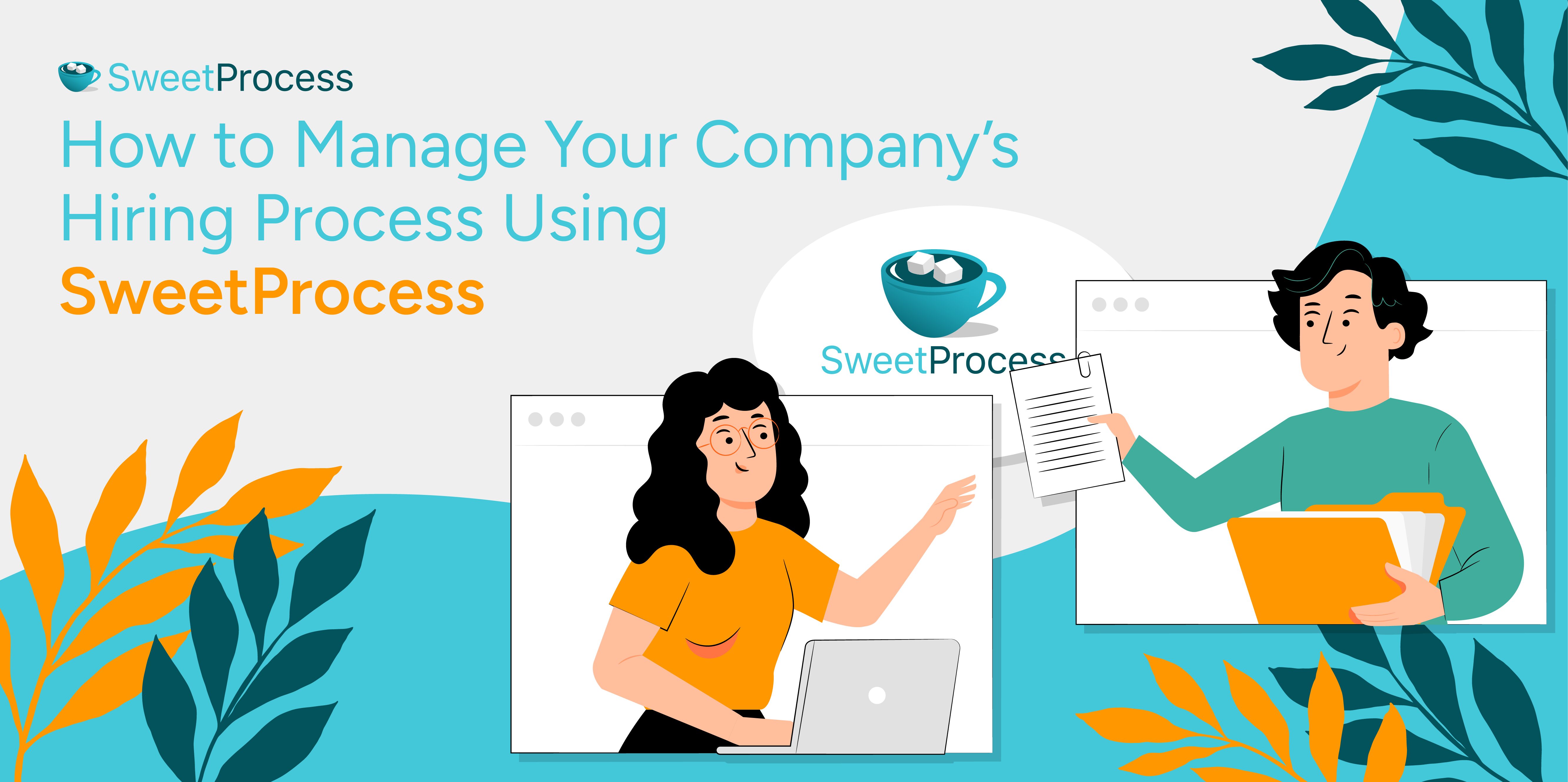
The hiring process comes with many moving parts. You have a lot of details that need to be captured, and missing any crucial part can sabotage your efforts.
This means you must be meticulous, and using the right tools can help you achieve this feat. This is where SweetProcess comes in. It is a platform equipped with tools to help you manage processes so you can enjoy a seamless and effective hiring process.
Here’s how SweetProcess can help you transform your hiring process:
Document Repetitive Tasks in One Place
Imagine having every repetitive task in your hiring process neatly documented in one central hub. No more hunting through emails or digging through files to find that checklist or procedure.
With SweetProcess, you can easily create step-by-step work instructions for every task, from scheduling interviews to onboarding new hires. This ensures everyone knows what to do, and nothing slips through the cracks.
Build a Quiz to Assess Your Team’s Grasp of Company Policies, Processes, and Procedures
How do you know your team’s on the same page? SweetProcess makes it easy to build quizzes that assess their understanding of key policies and procedures. As your team’s understanding deepens, so does their ability to engage and innovate within the hiring process.
Turn Procedures and Processes Into Actionable Tasks
Do you feel like your hiring process is a maze without a clear path forward? SweetProcess helps you break it down. You can transform your procedures into actionable tasks that guide your team step by step. Each task becomes a checklist of actionable tasks assigned to the right team member at the right time. From the first job posting to the final decision, you can track progress, update statuses, and keep everyone associated with the hiring process aligned and accountable.
Turn Existing Procedures and Policies Into a Beautiful Knowledge Base
Your company’s policies and procedures are gold. But if they’re buried in dusty files or scattered across platforms, they’re not doing anyone any good. SweetProcess lets you transform them into a sleek, searchable, functional knowledge base. You can now have a centralized location where team members involved in the hiring process can get answers to questions they might have.
Manage Procedures, Processes, and Policies
Effectively managing your hiring procedures, processes, and policies can be the backbone of a successful recruitment strategy. SweetProcess equips you with advanced features that streamline this management, ensuring your organization’s hiring process remains agile and transparent.
The first step is to sign up and gain access to your dashboard, equipped with so many features.
Here’s how these features can help transform your management approach and keep your hiring process running like a well-oiled machine.
Centralized Documentation
With SweetProcess, all your hiring procedures and policies are centralized in one accessible place. This means no more digging through files or asking colleagues for the latest version. Everything from job descriptions to interview protocols is just a click away, making it easier to manage updates and maintain consistency across all documents.
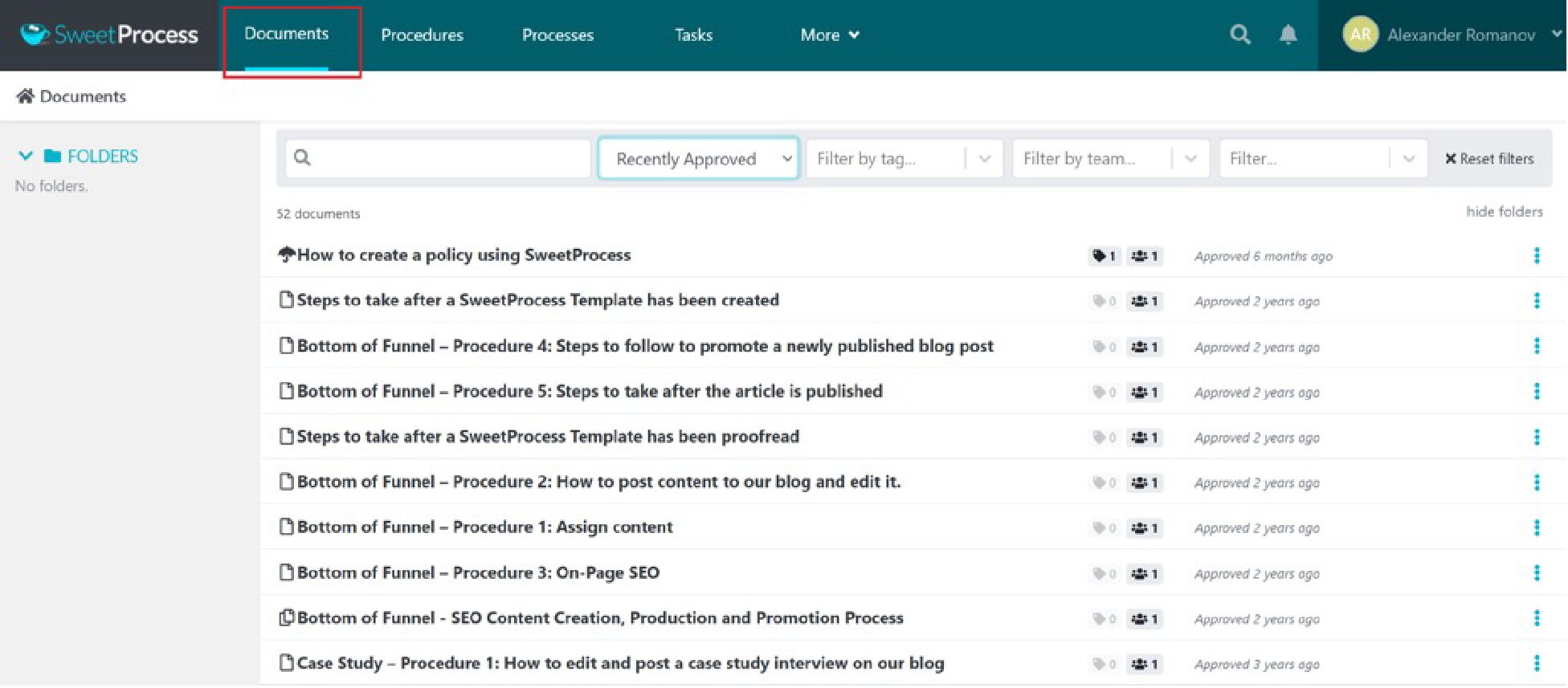
You can access all documents within your dashboard, as seen above.
Search and Sort
Need to update an interview procedure or share a policy? The SweetProcess search feature lets you pinpoint any document in seconds. Just type a keyword, and it’s right there.

Want to see what’s most relevant now? You can use the sorting feature to organize by recent activity, creation date, or even alphabetically. That’s efficiency at your fingertips.

Efficient Sorting and Filtering
Keeping track of numerous documents for your hiring process can be overwhelming. SweetProcess offers sorting options that organize your procedures and policies by recent activity, date, or alphabetically. Furthermore, you can enhance this organization with filters:
- Filter by Tags: Tag your documents with relevant keywords. Later, you can quickly retrieve them by selecting the appropriate tags, which is especially useful when dealing with a large volume of documents.

- Filter by Team: Assign documents to specific teams or departments. This filter ensures that only the relevant team members have access to pertinent procedures and policies, streamlining compliance and relevance.

- Filter by Activity: This filter allows you to track documents based on their status, whether they need approval, are in draft, or are pending review. It’s an essential tool for managing the lifecycle of each document and ensuring that you don’t miss out on anything.
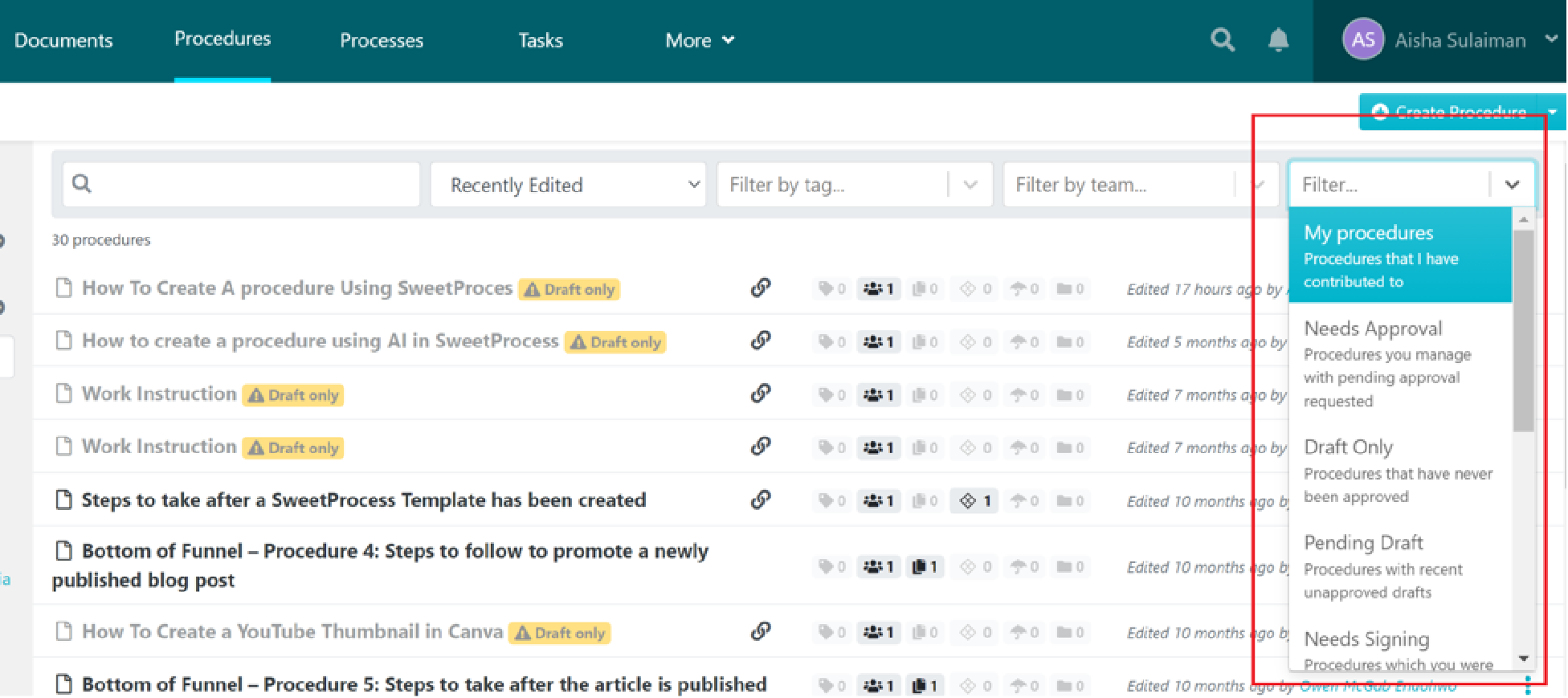
Collaborative Tools and Version Control
Each procedure and policy document within SweetProcess isn’t just a static file; it’s a collaborative space. You can view the version history along with other features on the left pane of your dashboard to track changes over time, which is critical for maintaining document integrity and audit trails.
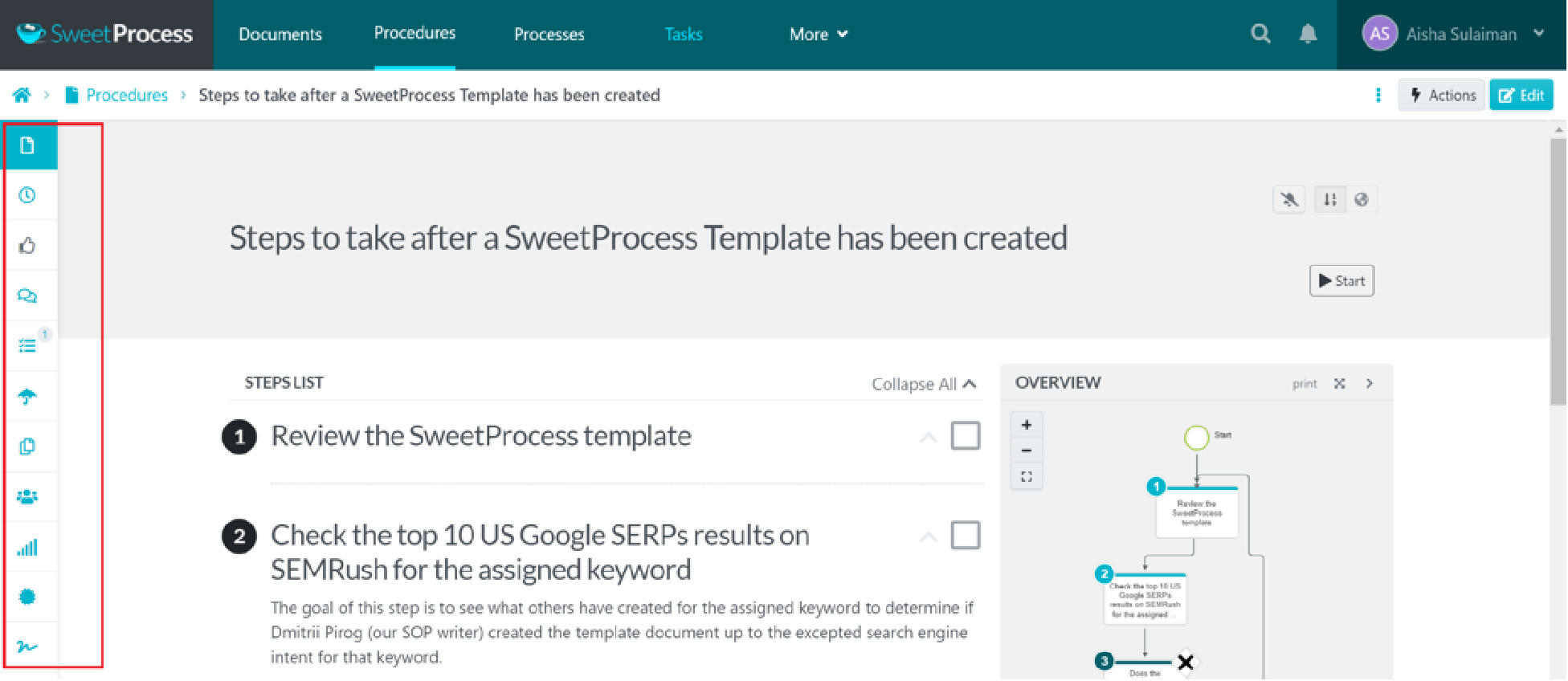
Team members can leave comments, suggest edits, and link related tasks directly within each document. This level of interaction fosters a collaborative environment and ensures that all team members are aligned and can contribute to continuous improvement.
Real-Time Updates
Hiring processes evolve, and SweetProcess evolves with them. You can make real-time updates to any document, and the changes are instantly reflected across your team. This ensures everyone works with the latest information, reducing errors and ensuring compliance with new policies or regulations.
Set up Your Teams to Reflect Your Company Culture
Your company culture defines how your team operates daily. SweetProcess makes it simple to design team structures that align with your values, ensuring every hire fits seamlessly into your culture. By using SweetProcess to standardize onboarding and integrate cultural touchpoints, you build advocates who reflect your mission and vision.
Several companies have been using SweetProcess to improve and streamline their hiring processes and have good results to show. At Thimbleberry Financial, the integration of SweetProcess was a game-changer. Previously burdened by chaotic scheduling and disjointed task tracking, they harnessed SweetProcess to transform their operational framework. The result? A highly efficient, smoothly running hiring operation that aligned perfectly with their strategic goals, making every recruitment count.
IMS ExpertServices faced significant challenges in maintaining consistency across their recruitment efforts due to knowledge gaps within their teams. By implementing SweetProcess, they established a robust framework that not only filled these gaps but also enhanced the strategic aspects of their recruitment process. This led to a more efficient system, streamlined workflows, and improved recruitment outcomes.
The case of XL.net showcases how clutter and inefficiency in business processes can obscure the hiring vision. With SweetProcess, they decluttered their operations, leading to a more streamlined and precise hiring process. This refinement significantly reduced their time-to-hire and improved the quality of their candidate pool, demonstrating the direct benefits of effective process management.
SweetProcess transforms the management of your hiring procedures and policies from a daunting task to a streamlined, efficient process.
Hiring Process vs. Onboarding Process: How They Differ
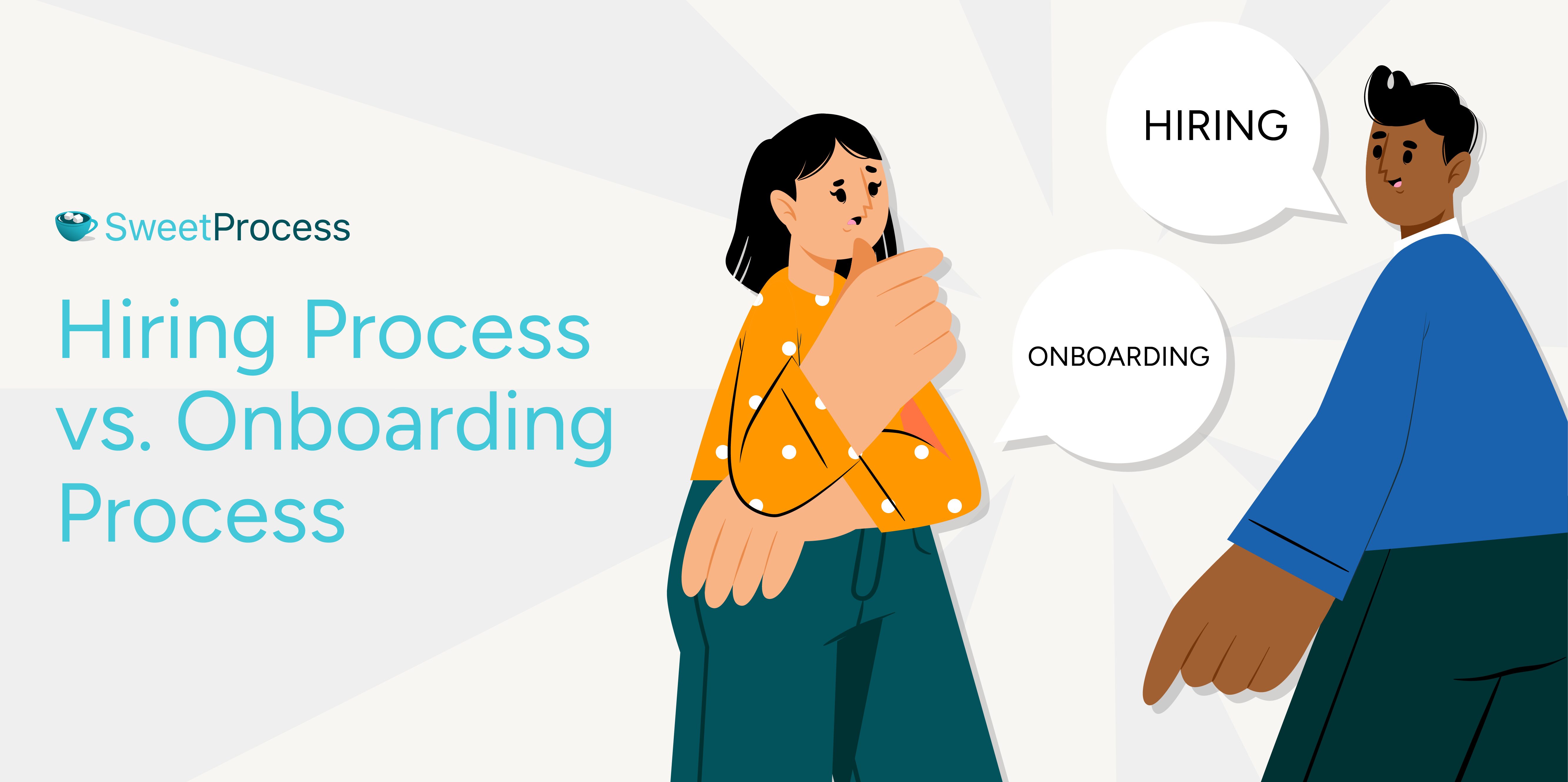
At first glance, hiring and onboarding might seem like two sides of the same coin. Both are about bringing people into your company, right? But they’re not quite the same. These two processes serve different purposes, and understanding their distinctions can help you make each one stronger. Think of hiring as opening the door and onboarding as guiding someone inside and showing them where they belong.
The hiring process involves finding and selecting the right person for the job. It’s the search for the perfect fit, the candidate who checks the boxes and feels like a natural addition to the team. Onboarding, on the other hand, starts once the hiring is done. It’s about making that new hire feel welcomed, supported, and prepared to thrive in their role.
Why It Matters
The biggest mistake companies make is handling their onboarding as an afterthought. But onboarding is where your investment in hiring pays off. It bridges the gap between “You’re hired!” and “Here’s how we do things.” If done right, onboarding transforms a new hire into a productive team member and fast.
Key Differences at a Glance
| Aspect | Hiring Process | Onboarding Process |
| Purpose | Attracting and selecting the best candidate for the job | Integrating the new hires into the company and preparing them for success |
| Timeline | Begins with identifying a need and ends with an offer | Starts after the hire and continues through their first weeks or months |
| Focus | Evaluating skills, experience, and cultural fit | Providing tools, knowledge, and relationships to succeed |
| Key Activities | Posting jobs, reviewing resumes, conducting interviews, and making decisions | Training, mentorship, team introductions, and cultural immersion |
| Outcome | A signed offer letter and a new hire ready to join | A confident, well-prepared employee who feels like part of the team |
The hiring process sets the tone for onboarding. The way you treat candidates during hiring (your communication, organization, and transparency) directly impacts how they’ll feel on day one. If hiring feels chaotic, onboarding may feel the same. Both processes need to be intentional and seamless.
5 Hiring Process Examples to Inspire Your Team
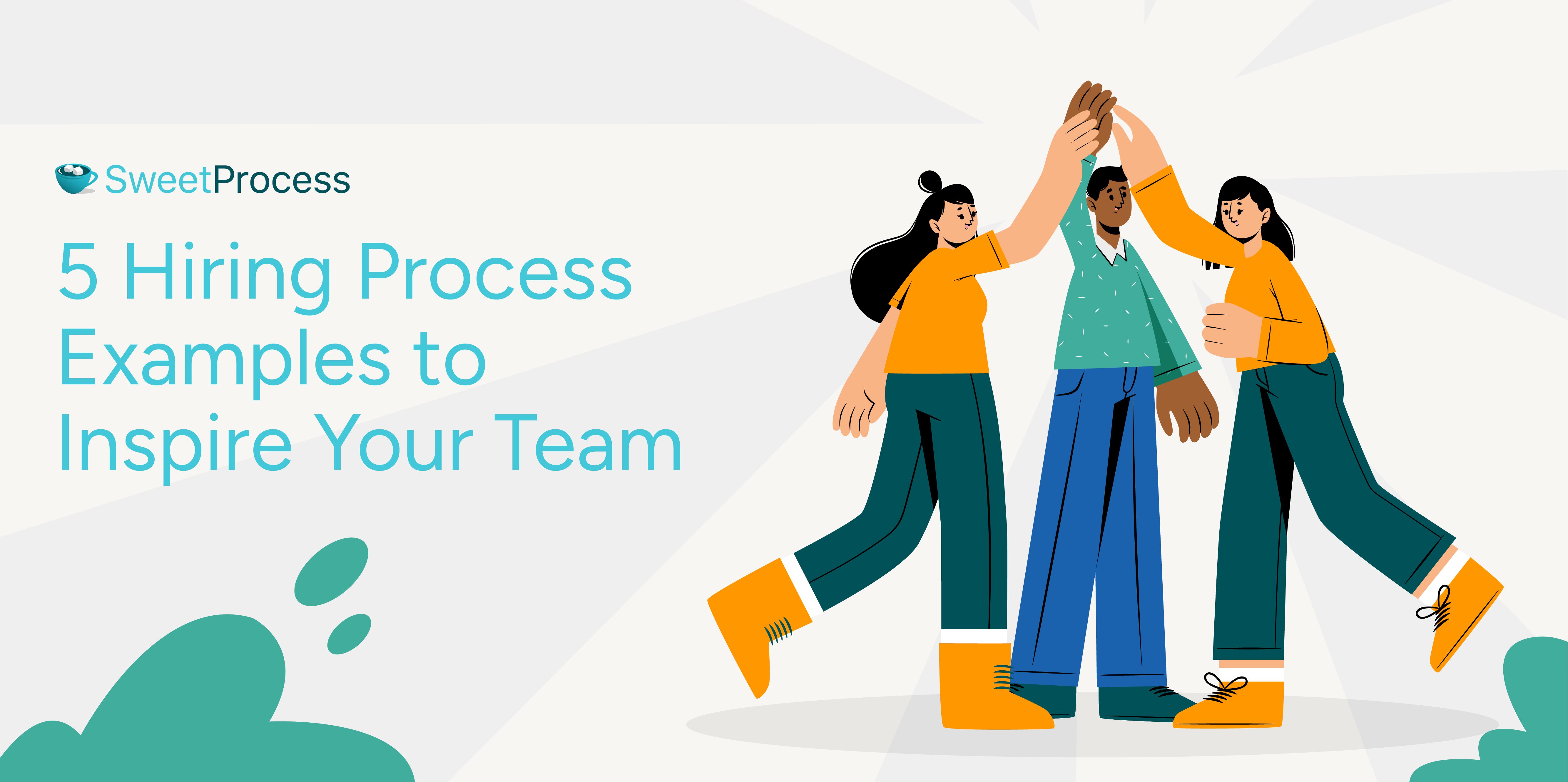
When it comes to hiring, there’s no one-size-fits-all solution. Different companies have different needs. But one thing’s for sure: a creative, thoughtfully designed hiring process can set your company apart, attracting the right talent and setting them up for success. Let’s take a peek at how some leading companies are doing it right.
Amazon: A Data-Driven Approach
Amazon’s hiring process is all about precision. They leverage data at every step, from candidate screening to interviews, ensuring that each decision is backed by evidence. Their famous “Bar Raiser” program includes interviewers from outside the hiring team to maintain high standards and eliminate bias.
Key Takeaway: Objectivity matters. A structured, data-driven approach minimizes biases and ensures consistent hiring decisions.
Buffer: Transparency at Its Core
Buffer has made waves with its open and transparent hiring process. They share job postings, salaries, and even candidate progress publicly. This radical transparency builds trust and attracts candidates who value honesty and openness.
Key Takeaway: Clear communication attracts candidates who resonate with your values, creating a stronger team alignment from the start.
Gallup: Strengths-Based Hiring
Gallup’s hiring process focuses on identifying and leveraging candidates’ unique strengths. They use their proprietary CliftonStrengths assessment (a personality test) to understand how potential hires will contribute to the team’s overall dynamics.
Key Takeaway: Hiring for strengths instead of just skills creates teams that complement one another, boosting collaboration and productivity.
Gumroad: A Remote-First Strategy
Gumroad’s hiring process is tailored to its remote-first company culture. They focus on asynchronous communication, use tools like Loom for video introductions, and prioritize written skills during selection.
Key Takeaway: Tailor your hiring process to reflect your work environment. If remote is your reality, design a process that identifies candidates who thrive in that setting.
SpaceX: Pushing the Limits
SpaceX’s hiring process is as rigorous as its engineering standards. They emphasize technical challenges and on-the-spot problem-solving to ensure candidates can handle high-stakes or innovative work.
Key Takeaway: Make your hiring process mirror the challenges of the job. The right candidates will rise to the occasion, showing their ability to thrive under pressure.
An effective hiring process is, therefore, unique for each company. But you can capture your unique process with the right tool.
SweetProcess can help you document all processes, procedures, and policies related to your hiring process all in one place for seamless top talent acquisition. Get started by testing SweetProcess with the 14-day free trial to see how it can help you streamline and create an effective hiring process.
9 Benefits of the Hiring Process in an Organization
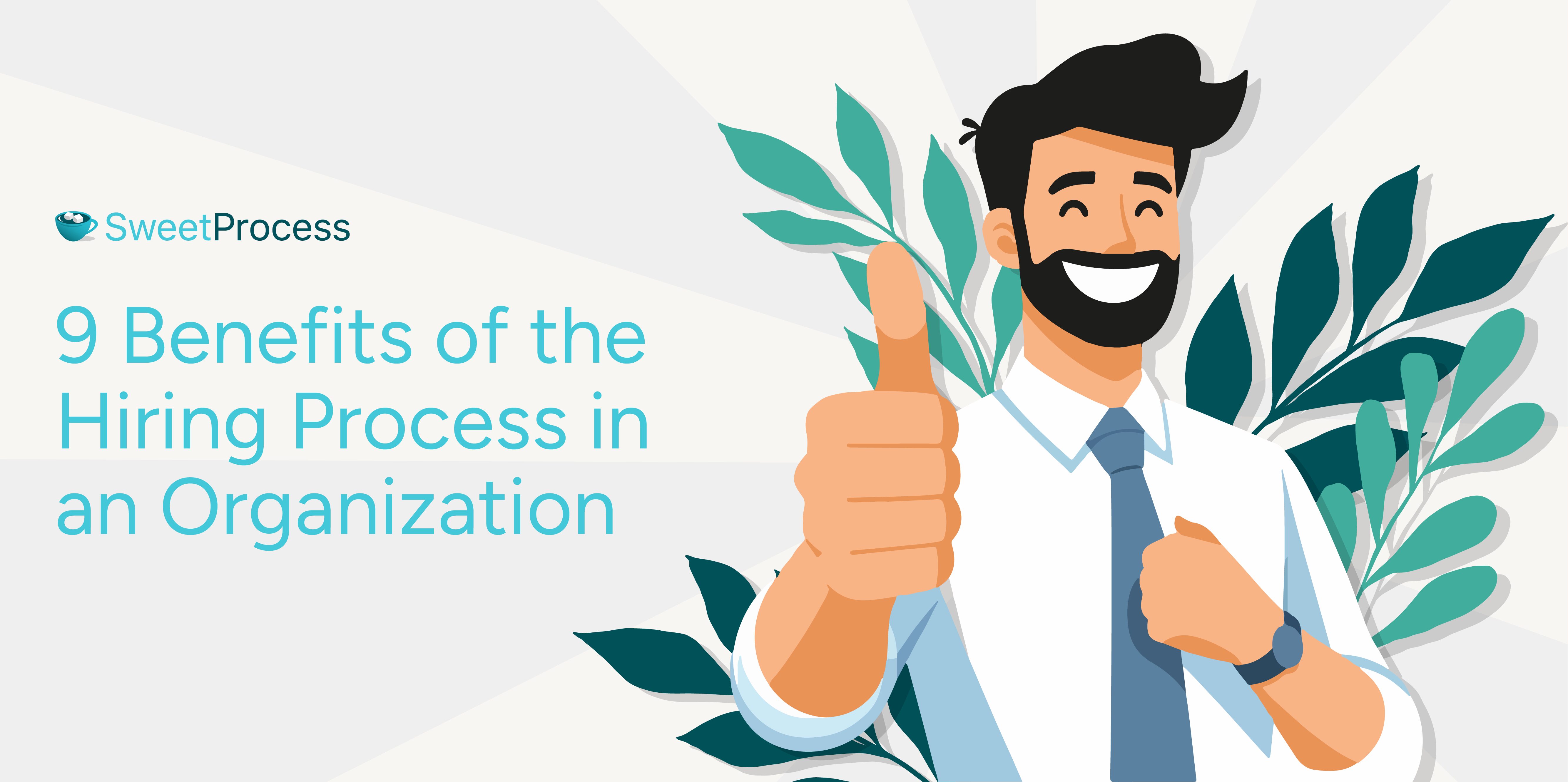
Having an effective hiring process in place is an opportunity to transform your organization significantly for the better. Here’s how a well-structured hiring process can become a game changer for your business:
1. Quality Applicant Pool
A meticulous hiring process acts like a magnet for top talent. By clearly defining the role and your expectations, you attract candidates with the right skills. You also get to work with candidates genuinely interested in growing with your company.
2. Accurate Screenings
Precision in your initial screenings can save you a lot of headaches later. When you set stringent criteria and use robust screening tools, you ensure that only the most suitable candidates move forward. This means fewer round pegs in square holes, as everyone fits just right.
3. Employer Brand Enhancement
Your hiring process is a reflection of your company’s brand. A smooth, respectful, and engaging process enhances your reputation, making your company a desirable workplace. What’s better than candidates eager to join you before submitting their application?
4. Improves Scalability and Flexibility of Recruitment
As your business grows, so do your hiring needs. A robust process is scalable, adjusting to increased demands without losing effectiveness. It’s the backbone that supports growth without compromise.
5. Faster and More Efficient Recruiting
Streamlining your hiring steps means you can move candidates through the process quicker and more efficiently. This reduces downtime and ensures that critical roles aren’t vacant for long.
6. Employer Branding Expertise
A solid hiring process builds your brand as an employer. Each interaction is a chance to showcase your values and culture, attracting those who align with your vision. Imagine how powerful it is to have employees who don’t just work for you but believe in what you stand for.
7. Enhanced Speed of Hire
When your hiring process is dialed in, you can significantly reduce the time it takes to fill a position. Faster hiring translates into a more agile workforce that can seize opportunities and minimize productivity losses.
8. Ensuring Compliance and Mitigating Risk
A standardized hiring process helps maintain compliance with regulations and employment laws, reducing the risk of costly legal issues. Peace of mind comes from knowing you’re doing things by the book and maintaining your standards.
9. Better Insight Through Analytics
With a structured hiring process, every step generates data that can be analyzed to refine and improve your methods. This continuous improvement cycle means you’re always a step ahead, optimizing your strategies for better results.
A robust hiring process fills gaps and strengthens your entire organization.
Recruit Top Talent for Your Team With SweetProcess

The right people aren’t just found. They’re attracted and brought on board through a process that reflects your company’s heart and soul. Your hiring process is the beginning of a relationship that can elevate your entire organization.
Why settle for a hiring process that fills positions when you can have one that brings in visionaries, innovators, and game changers? With SweetProcess, you create not just a workflow but a lifeline that infuses your team with fresh energy and aligns perfectly with your corporate brand.
Are you ready to transform the way you hire? To build an effective hiring process that not only fills the gaps but also bridges the distance between today’s and your most ambitious goals?
Sign up for the 14-day free trial of SweetProcess and start your journey toward hiring excellence. Make the choice to empower your teams, enhance your brand, and enlist the best talent out there.
